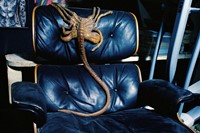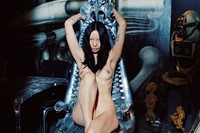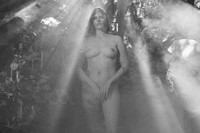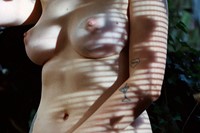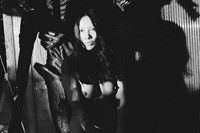Camille Vivier talks about shooting nude models in the treasure-filled home of HR Giger – the eccentric, Swiss-born creator of the monster in Ridley Scott’s movie Alien
Where others see body horror, Camille Vivier finds warmth in the work of HR Giger. In her latest book, HR Giger by Camille Vivier, Vivier shot the Swiss artist’s home in almost obsessive detail, after becoming unknowingly exposed to his work as a child via Debbie Harry’s KooKoo album cover. Vivier understands the late artist intimately; in her book, models pose naked in the snow of his Zurich torture garden, the biomechanical playground behind his seemingly suburban house.
What started as a fashion story thought up with her editor, Beda Achermann, changed when she discovered that the place had room after room of undocumented treasures filled with objects and sculptures – all of which were then punctuated with her signature, contemplative nudes. “The subject seemed endless,” says Vivier. “I was excited because years earlier I had tried contacting the Giger Museum and bar in Gruyère, without result. But the house had never been shot before. It was this infinite source of visual wonders.”
Familiar with the themes running through his designs for the Alien movies before starting the book, she explains the recent Giger revival as an echo of how we now perceive ourselves physically. There are unlimited possibilities for reshaping our bodies, optimising our performance, augmenting our realities, even living part-time in our machine-generated metaverses, drawing parallels today with filmmakers like Julia Ducournau or David Cronenberg as much as Ridley Scott.
“I’m not an expert on transhumanism or cyberculture but I can see why his art resonates. You also get this sense of a world in danger coming through,” says Vivier. “It’s hard not to think about chaos when you look at Giger’s work, something we’re all experiencing and trying to process using our own different coping strategies. Science fiction seems more real than ever.”
Here, a few days after her Paris book launch at Le BAL, Vivier talks about metal becoming as organic as flesh, stumbling on a stash of goth pop ephemera from her past, and why the Swiss find eccentrics like Giger far from odd.
Ben Perdue: Can you recognise any similarities or contrasts between Giger’s work and your own that make them work so well together?
Camille Vivier: Giger was a man from a different time. But his interest in women’s bodies, anthropomorphic shapes, fantasies and the unconscious are all linked. His work is darker, more ‘metal’ and more dystopian but there is also a lot of humour which is something I appreciate and try to inject into my work. Not camp exactly but it could be reconsidered from this angle.
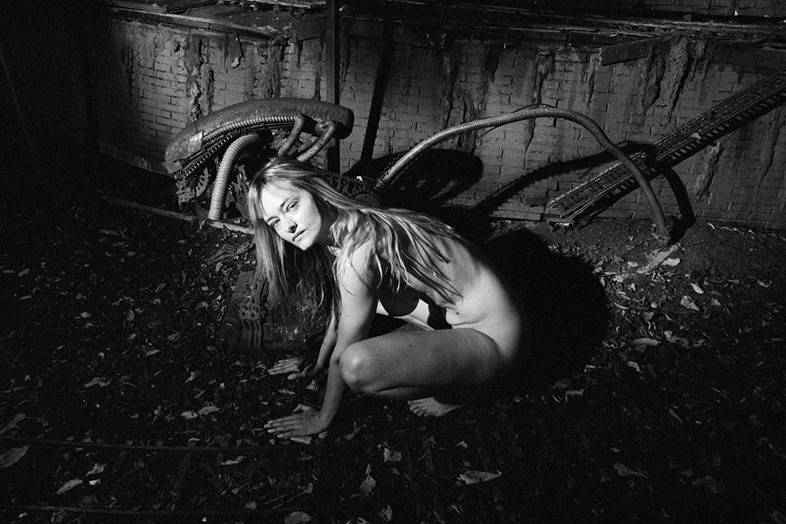
BP: Did it feel strange to treat his house and garden more like subjects than just another shoot location?
CV: It felt more exciting and more immersive but not that different. Even if I had to pay attention to details, it never felt restrictive – quite the opposite. Each room and corner of the house already feels like a stage. The interactions between the furniture, the sculptures and the models were joyful. The house is a character in itself. Maybe that’s the mythology behind Giger’s work but it was like a movie set or playground – especially the garden with its miniature train. I could easily shoot without feeling restricted or bored.
BP: Was the atmosphere in the house dark or unsettling?
CV: I wasn’t expecting to feel comfortable but there is something very soft about the environment, it’s intimate and touching. It never felt like a museum, like artists’ houses often do. You don’t see the objects as relics. You can feel a warm presence because it is still an inhabited place. Carmen, Giger’s wife, lives here and Tom, his old assistant, has a space for work. The rooms are full of objects and paintings by Giger, furnished with prototypes for Dune and other film projects, but nothing seems too ostentatious. The studio has an almost ’in utero’ feel.
BP: Could you feel more of the artist’s less public persona coming through, being surrounded by his belongings?
CV: You get a real sense of underground Zurich in the 1970s and 1980s, there are Polaroids lying around of his friends, like the muse Lady Shiva or Swiss artist Manon. Also, books, vinyl and VHS tapes, but it can all feel a bit random – a beautiful table designed by Giger with a Wi-Fi box on top, or an Eames chair with a baby alien sitting in it next to an exercise bike. Carmen taught me a lot about him with her funny anecdotes, and I was often left alone which helped me get a better understanding of his universe.

BP: What was the strangest or most surprising object you discovered?
CV: In the same room: teddy bears, dreamcatchers and a drawer full of archived work for Mylène Farmer, a French goth pop icon from my childhood!
BP: As a photographer, what do you make of those Polaroids he shot of his muses from the 70s and 80s?
CV: I’ve always liked their strength; they feel aggressive. They remind me of Carlo Mollino’s Polaroids but with a more obvious sexual charge. There is no full-frontal nudity, most of the women are wearing airbrushed bodysuits, but their attitude is sexy – they seem dangerous or in danger, it’s hard to say. They look like Giger’s creatures. You can feel his proximity with the models, so they’re probably friends, it feels real. The space seems more neutral and minimal than his house – Giger often used his own airbrush paintings as backgrounds that combined seamlessly with the body painting. I like them as a testimony, but also for their powerful homemade aesthetic.
BP: Do you think your own models’ unaltered bodies help emphasise the strangeness of his bio-mechanical creations?
CV: Yes, the bare body always lends some strangeness, tension or absurdity to any situation but here it contrasts even more with Giger’s creatures – the sophistication of his work next to the harsh simplicity of the women’s bodies. Their feminine presence calms his more phallic elements, while at the same time melting perfectly into each other. Metal is as organic as flesh in Giger’s work.
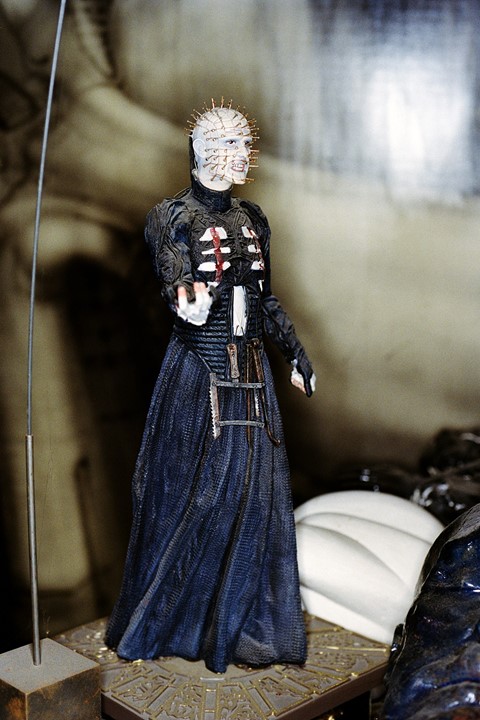
BP: What did you love about the space, and what did you find most challenging or difficult about it?
CV: I loved that it’s a domestic space too but it could be challenging finding the right angle, or getting enough distance, physically and figuratively speaking. Creating a body of images about an artist’s work and environment can be complicated but it’s an exercise that I like, as using cultural or pop references is something I regularly integrate in my own work.
BP: And did the models find the experience as enjoyable, do you think?
CV: It was a lot of fun for everyone, and I think it was just as inspiring for them to be in the environment. I’m never too prescriptive and like the models to behave how they want to – some were really performing, some were quieter, just observing the place. Yesh was brave, she’s a model and singer from New York who did part of the shoot in the snow.
BP: Finally, were the neighbours able to give you any insight into what it was like living next door to an artist as famously eccentric as HR Giger?
CV: I never got to meet them, but from the outside you can’t see the garden and the house looks very normal, just another simple suburban house. I do know that they were aware of who he was, but I don’t think it was a problem. On the contrary, Giger is a national treasure! And anyway, Switzerland is full of oddities.
HR Giger by Camille Vivier is published by Scheidegger & Spiess on 12 December 2022.
